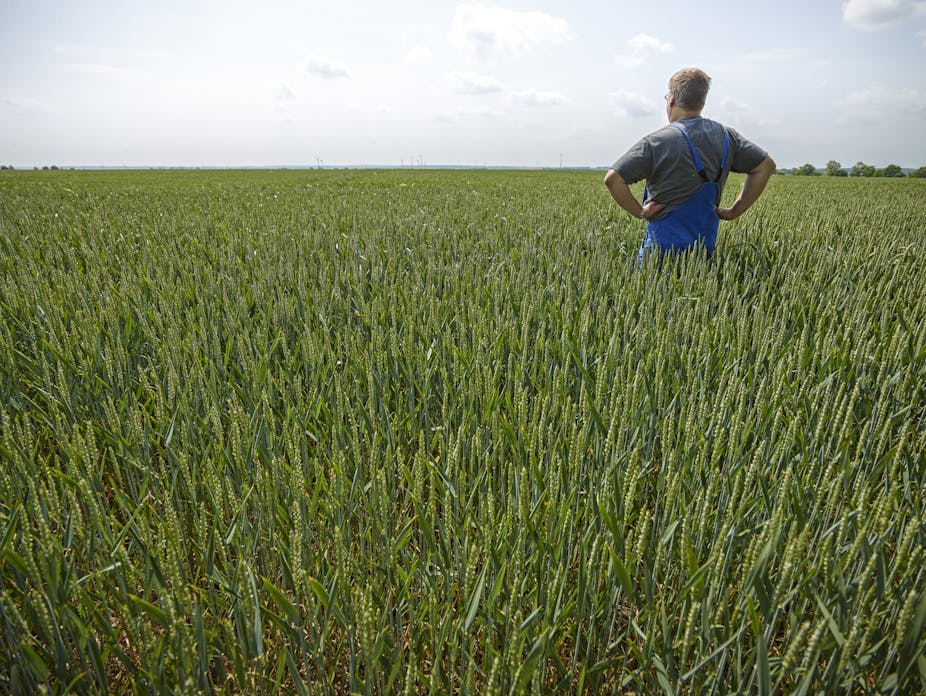The European policies designed to encourage a more biodiverse environment that is better able to support wildlife and plants are failing. In fact, our analysis of the reforms designed to “green” the EU Common Agricultural Policy (CAP) suggests they neither encourage greater wildlife abundance nor provide adequate protection for vulnerable habitats such as grasslands.
Finally adopted in March, the long process of reforming the CAP was supposed to require farmers to “observe practices beneficial to the climate and environment” in order to qualify for some of their direct payment subsidies, as well as offering pro-environmental farm stewardship as a voluntary step.
While we depend upon the food grown in agricultural fields we also benefit from the environment to which they are a part, from the wildlife such as the iconic skylarks lauded by Vaughan Williams, or the “green and pleasant land” of a traditional, diverse rural landscape. Land given over to agriculture should produce more than just food and profits, but things of a wider worth to society.
The reformed CAP is an effort to recognise that we should pay farmers to produce both. Much of Northwest Europe’s farmland is now monotonous, monocrop farmland, degraded and denuded of its wildlife. Eastern Europe’s more traditional landscapes remain wildlife rich, and the policies’ green measures should help protect them, while encouraging farm modernisation. This is the aim but not, we discovered, the reality.

Shades of green
In the UK, the Advertising Standards Agency (ASA)’s code on environmental claims says words such as “greener” can be justified if the advertised product provides a total environmental benefit over that of the marketer’s previous product, and the basis of the comparison is clear. Let’s apply this logic to the CAP reform.
As part of a team of environmental and farming experts from across the EU, we analysed the “greening” credentials of the new CAP relative to the old one. Our results, published in the journal Science, reveal that, alarmingly, the reformed CAP fails the ASA test: there is no basis for claiming that it is greener.
While many farmers across Europe have in the past volunteered to receive payments for the so-called “agri-environment schemes”, some of which have provided environmental benefits, this budget has shrunk by almost 20%. For the reformed CAP to increase its environmental benefit overall, any benefits lost as a result would have to first be replaced.
The reformed CAP introduces three measures: Ecological Focus Areas, in which 5% of agricultural land is managed to provide habitat for wildlife. Maintaining 95% of permanent grasslands, home to many wildflowers and the insects and birds they support, from being ploughed into fields. And the requirement to grow at least three crops on arable farms over 30 hectares in order to generate a more diverse landscape.

Not living up to expectations
Ecological Focus Areas will only work if they provide the right habitat for wildlife in the right place. But the scheme doesn’t include those interventions known to help wildlife, such as flowers planted for pollinators, or plots for ground-nesting birds.
And in any case, the payment rests on simply having them, rather than managing them in the right way or in the right place to make a difference. Management is critical to making any real difference – hedgerows, for example, are not much good for birds and insects if they are cut short every year and hardly allowed to flower. Fallow land is poor for wildlife if it is sprayed with herbicide in late spring to prevent weeds colonising crops.
The measure designed to protect permanent grassland, doesn’t. A farmer can continue to collect the subsidy if they convert a patch of flower-rich meadow into an intensively-managed improved pasture field, because it is technically still “grassland”. If taken up, the 5% reduction allowable under the scheme will over the six-year lifespan of the current CAP represent more than double the rate of loss of permanent grassland that occurred between 1993 and 2011, when just over 6% of Europe’s grasslands were lost.
As for the three crop rule, there is no evidence that having three crops, rather than two or one, provides any environmental or diversity benefit. It entirely depends on which crops are planted, and how they are managed – for example, what pesticides are used and when. Even now in half of EU member states the average arable farm already has four or five crops, so requiring three will not provide any additional environmental benefits.
On top of it all, most European farmers and about half the farmed area are in any case exempt from Ecological Focus Areas and minimum crop diversity, because they don’t apply to livestock farms or small arable farms.
The message that, after hard-won reform, the CAP is now greener is really appealing to society, so it’s particularly unfortunate that our analysis indicates that it is nothing of the sort. It’s important that national governments recognise that our evidence-based analysis indicates a shortfall between rhetoric and reality, and do what they can in their own power to improve matters.
It is also up to us, as citizens and consumers, to recognise that relying on food to be cheap and plentiful implies that sustainable farming will take second place. If we don’t like this choice, it’s up to us to voice it.

